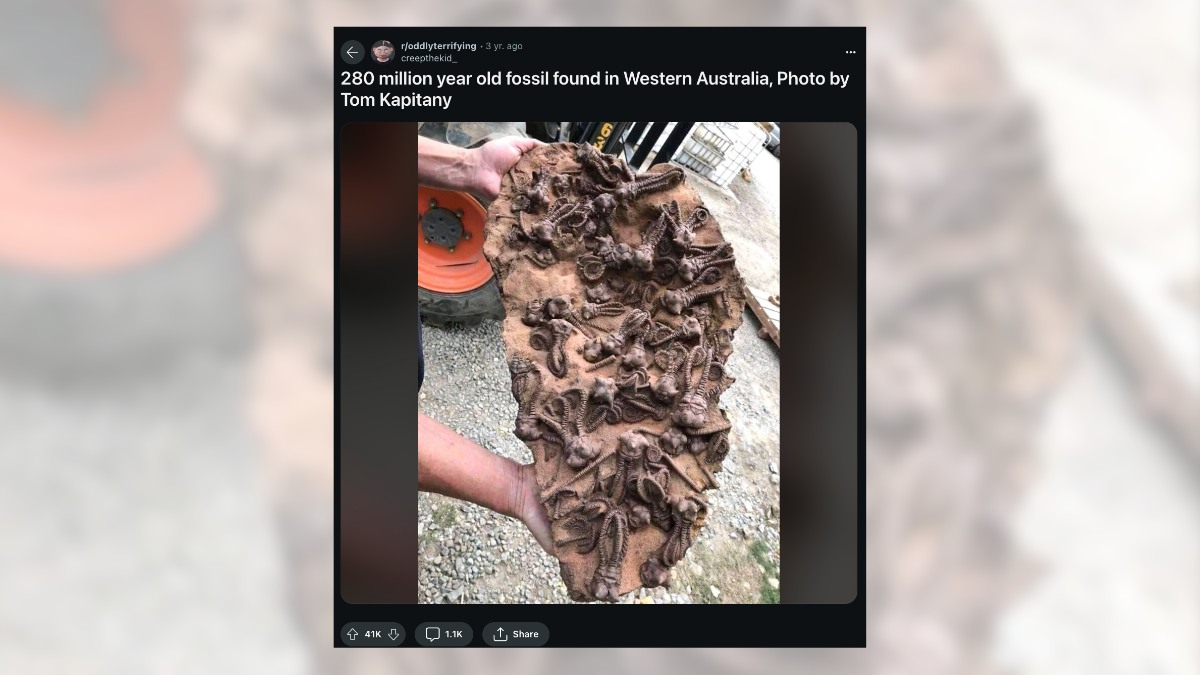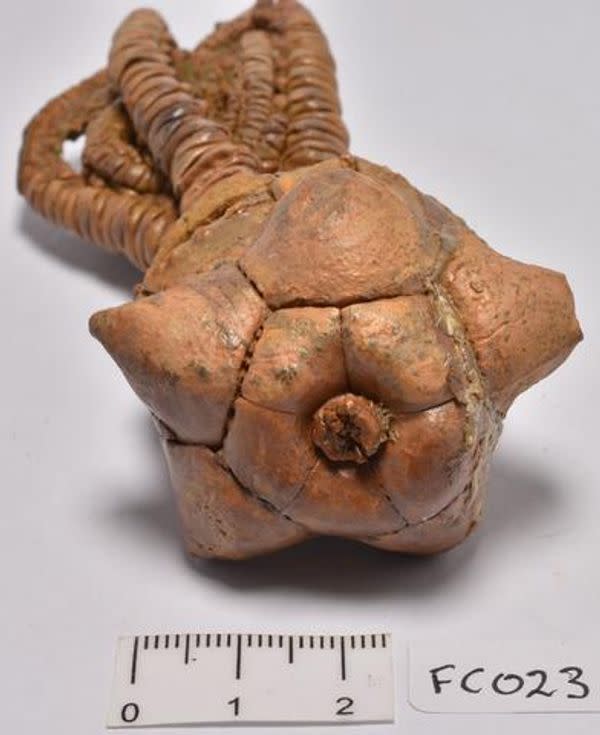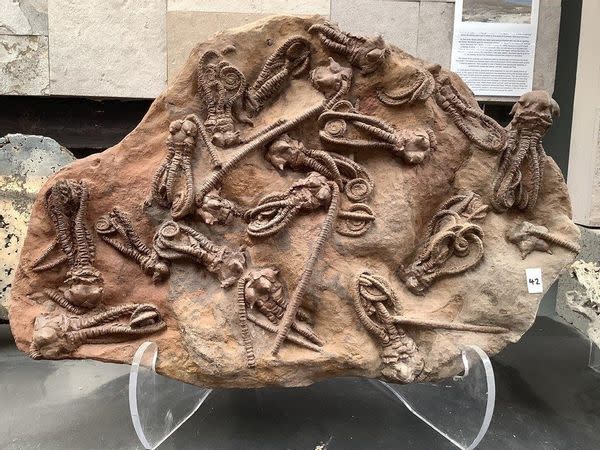Fact Check: About That 280M-Year-Old, 'Alien-Looking' Fossil Allegedly Found in Western Australia

Claim:
A photograph shared to social media in mid-2024 genuinely showed an estimated 280-million-year-old fossil found in Australia.
Rating:
A photograph of tentacled arms and octagonal-shaped heads, said to depict a group of ancient, "alien-looking" organisms, made the rounds of social media channels in June 2024. Such online posts claimed to show a "280 million-year-old Australian fossil." Many of these posts credited the photo to Tom Kapitany, including the Reddit post below, which had more than 41,000 upvotes at the time of this publication.
280 million year old fossil found in Western Australia, Photo by Tom Kapitany
byu/creepthekid_ inoddlyterrifying
To investigate this claim, Snopes first conducted a Google keyword search on Kapitany's name, which returned a result of Crystal World Exhibition Centre in Australia, an Australia-based exporter of minerals and fossils. Snopes contacted Kapitany, who confirmed that both the picture and fossil were genuine, and we have rated this claim "True."
In an email to Snopes, Kapitany identified the fossil as a mortality plate, or a fossilized representation of a mass dying event of an assemblage of species. The fossil contains more than a dozen specimens of a species known as Jimbacrinus bostocki. J. bostocki was a type of marine organism called a "crinoid," described by the Crystal World Exhibition Centre in Australia below:
Crinoids are marine animals (not plants), with this particular species inhabiting the deep-sea seafloor. As the crinoids belong to the Echinoderm phylum, it is related to starfish, brittle stars and sea urchins. Crinoids have kept the same basic body shape throughout time.
As they are seafloor animals, the Jimbacrinus bostocki had a stalk to attach itself to the seafloor substrate. These stalks are made up of flexible, porous columnal "discs" connected by soft tissue. The stalk is also hollow, like an internal tube and this is where the nervous system is located. Oxygen is absorbed through thin walled tube feet.
J. bostocki could reach lengths of more than 8 inches long. With five arms lined with feathery-looking, tentacle-like structures called pinnules, they fed on planktonic particles and detritus – or sloughed-off organic material – in the surrounding water column.

(Crystal World Exhibition Centre in Australia)
The mortality plate was found along a dry creek bed of the Gascoyne River in Western Australia. This location is home to the Cundlego Formation, a sandstorm formation created during flooding and storm deposits during the Permian era, about 275 million years ago.
"This fossil deposit also gives us a snapshot into the extinction events of the Permian Period," according to the Crystal World Exhibition Centre website.

( Crystal World Exhibition Centre in Australia)
The end of the Permian and beginning of the Triassic eras is known as the "Great Dying" and represents the largest and most severe great extinction events recorded over geological time. It's unknown what caused this catastrophic event. Still, NASA reports that it may have been caused by "severe volcanism, a nearby supernova, environmental changes wrought by the formation of a super-continent, the devastating impact of a large asteroid — or some combination of these."
An estimated 90% of marine species and 70% of land species "vanished" from Earth. "Life on our planet almost came to an end," according to NASA.
Kapitany referred Snopes to a research article he co-authored that was published in Alcheringa: An Australasian Journal of Paleontology on Feb. 21, 2024. It described the crowns of the J. bostocki as being preserved in the protective "trauma" posture. It is thought that storm-driven ocean currents may have transported large groups of these species to deeper waters that were possibly anoxic or lacking oxygen. Scientists hypothesize that individuals in the mortality plate were "smothered by sediment and rapidly buried."
The fossil was since sold to a party in China, Kapitany told Snopes.
Sources:
"15+ Things We Never Expected To Discover About Our World." Diply, 8 Sept. 2020, https://diply.com/141953/15-things-we-never-expected-to-discover-about-our-world.
"About Us." Crystal World Exhibition Centre and Sales, https://www.crystalworldsales.com/pages/about-us. Accessed 10 June 2024.
"---." Crystal World Exhibition Centre and Sales, https://www.crystalworldsales.com/pages/about-us. Accessed 10 June 2024.
EarthWord–Mortality Event | U.S. Geological Survey. https://www.usgs.gov/news/science-snippet/earthword-mortality-event. Accessed 10 June 2024.
JIMBACRINUS BOSTOCKI – Crystal World Australia. https://www.crystalworld.com.au/2021/02/25/jimbacrinus-bostocki/. Accessed 10 June 2024.
Large Block of Early Permian Cundlego Formation Siltstone | Western Australian Museum. http://museum.wa.gov.au/research/collections/earth-and-planetary-sciences/fossil-collection/large-block-early-permian-cundle. Accessed 10 June 2024.
Log in or Sign up to View. https://www.facebook.com/login/. Accessed 10 June 2024.
---. https://www.facebook.com/login/. Accessed 10 June 2024.
The Great Dying - NASA Science. https://science.nasa.gov/science-research/earth-science/the-great-dying/. Accessed 10 June 2024.
Tom Kapitany - Google Search. https://www.google.com/search?q=Tom+Kapitany&oq=Tom+Kapitany&gs_lcrp=EgZjaHJvbWUqBggAEEUYOzIGCAAQRRg7MgYIARBFGDsyBggCEEUYOzIGCAMQRRhAMgYIBBBFGD0yBggFEEUYPTIGCAYQRRg90gEHNjg3ajBqN6gCALACAA&sourceid=chrome&ie=UTF-8. Accessed 10 June 2024.
Willink, Robbert J., and Tom Kapitany. "The Crinoid Jimbacrinus Bostocki from the Lower Permian Cundlego Formation near Gascoyne Junction, Western Australia." Alcheringa: An Australasian Journal of Palaeontology, Mar. 2024, pp. 1–15. DOI.org (Crossref), https://doi.org/10.1080/03115518.2024.2323461.

 Yahoo News
Yahoo News 
